Another Night Mode stunner.
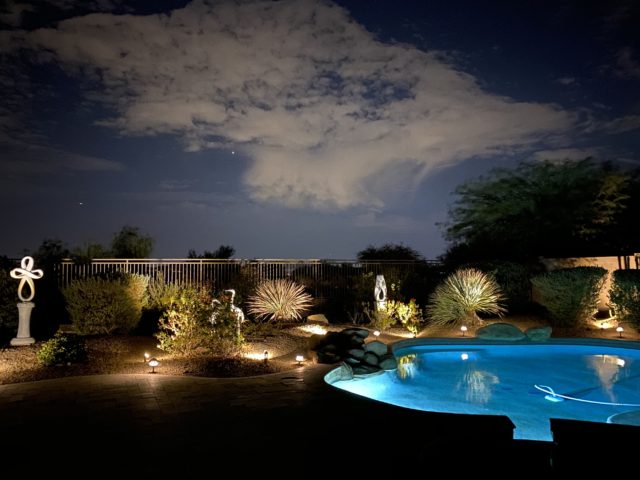
iPhone 11 Pro, 3 seconds, handheld.
Another Night Mode stunner.

iPhone 11 Pro, 3 seconds, handheld.
In beautiful Scottsdale.

iPhone 11Pro snap.
The scissor jack and related modifications were detailed in Part IV.
The primary use of the jack is to raise the motorcycle close to its fore and aft fulcrum, using the oil sump as the jacking point. This process is required when either wheel has to be removed with the bike on the lift. The front wheel cannot be removed without use of the jack as it is anchored in the vise on the lift’s table. The rear wheel cannot be removed without use of a jack as my BMW airhead favors the rear wheel at rest. And the center stand cannot be deployed safely on the table without considerable strength and a host of related issues. As the bike is pulled up and back onto the center stand it moves back several inches, which cannot be done if the front wheel is in the vise, though there is a way to do this. See below.

A 3/8″ socket drill adapter is used in a hand drill to raise the jack’s platform close to the oil pan. The screw in the jack has a fine pitch to confer mechanical advantage (not much stress on the user) but the trade off is that a lot of cranking is required. The electric drill makes this a speedy process.
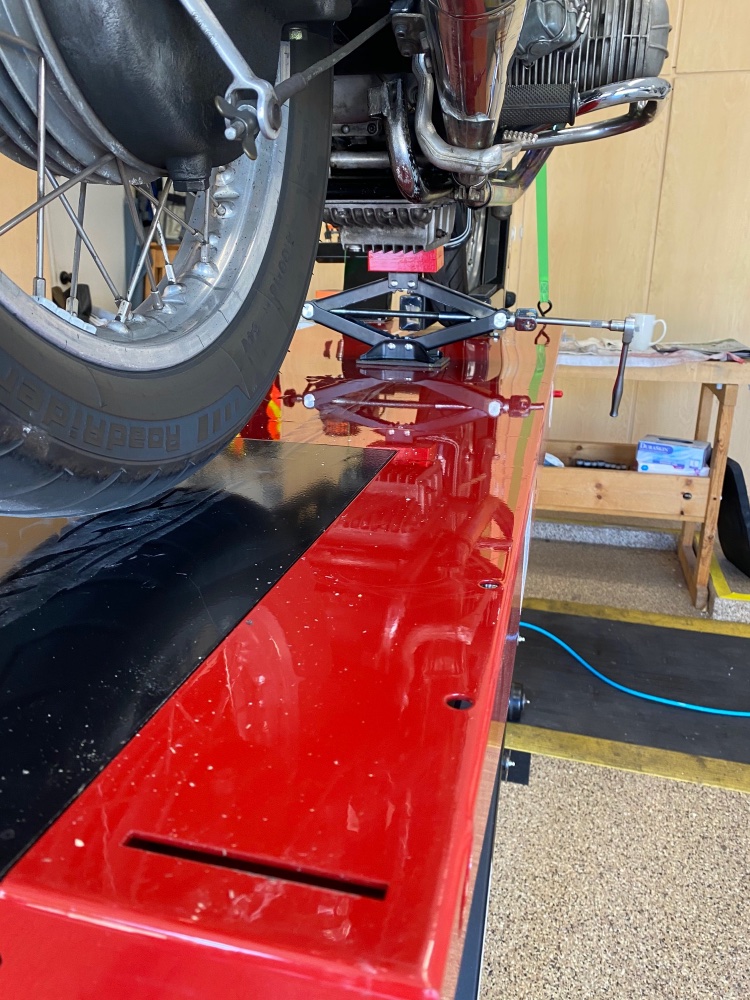
The front part of the oil sump is just ahead of the bike’s center of gravity which resides an inch or two behind the center stand pivot. That’s a small distance so there is very little turning moment on the jack itself, and little risk that it will tip forward.
As the ratchet is cranked first the rear wheel will rise off the table, permitting removal of the drop-in rear panel, removal of the wheel’s axle (one pinch bolt and one axle nut). The wheel can then be dropped down through the open panel space.
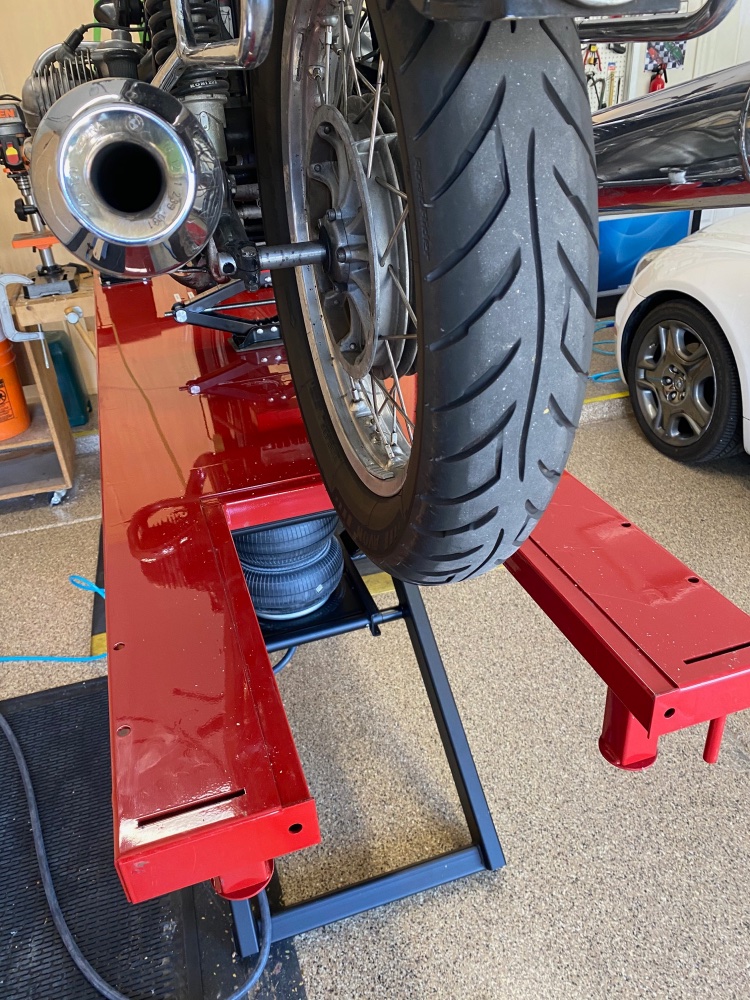
As the ratchet is operated and the bike rises, the front wheel, still clamped in the vise, permits rotation of the machine about the front axle. I have tie down straps installed at the front and these tighten up slightly as the front shock compresses. I did not find any need to loosen the tie downs.
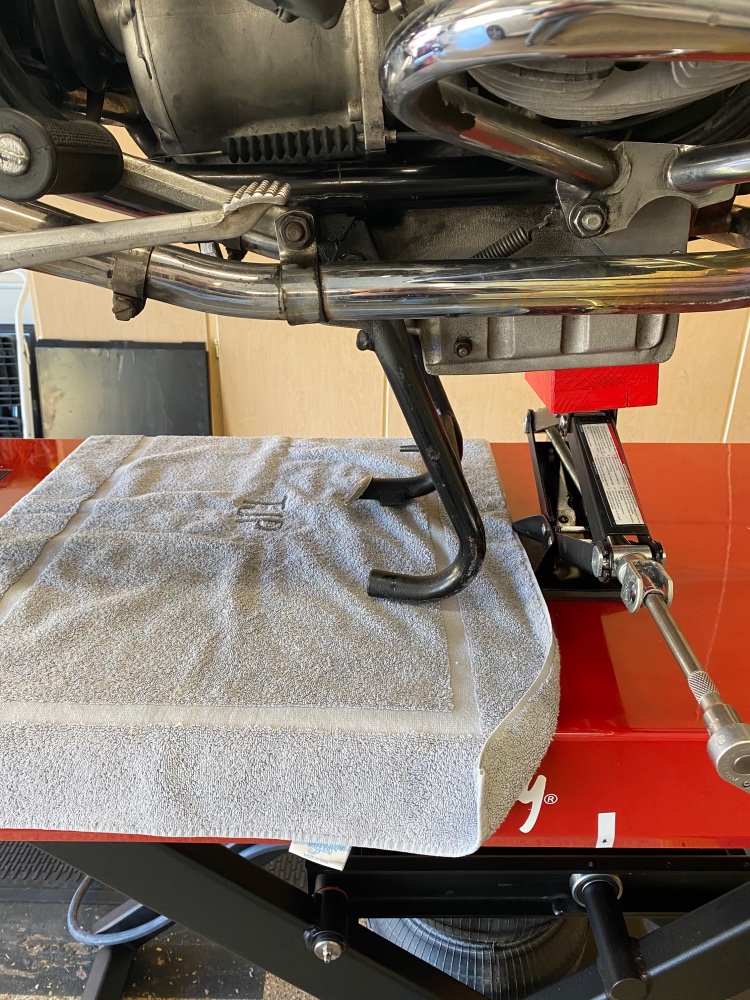
If you are really strong and a master mechanic like William Plam, you can slam the center stand forward with the front wheel locked in the vise using skill and strength, scratching up your table’s surface in the process. You can see William do this at 27:03 in this video. His large collection of professionally made videos is a joy to watch, full of his decades of expertise and containing lots of tips and techniques. Highly recommended.
I am neither strong, nor a master mechanic and do not like scratched up tools, so I keep cranking on that ratchet until the bike rises a couple more inches at which point the center stand can be deployed by hand, no strength involved. As you can see, I use a monogrammed towel to protect the surface of the table. You can use a plain one if that’s all you have.
At this point the jack can be dropped and removed. If you are pulling the rear wheel you must secure the cross rail of the center stand to the front wheel’s rim, or to the exhaust cross flow pipe, or to the vise on the table. This obviates the risk of the bike falling off the center stand which has no rear wheel to prevent it doing so in the event the front wheel is not locked tightly in the vise.
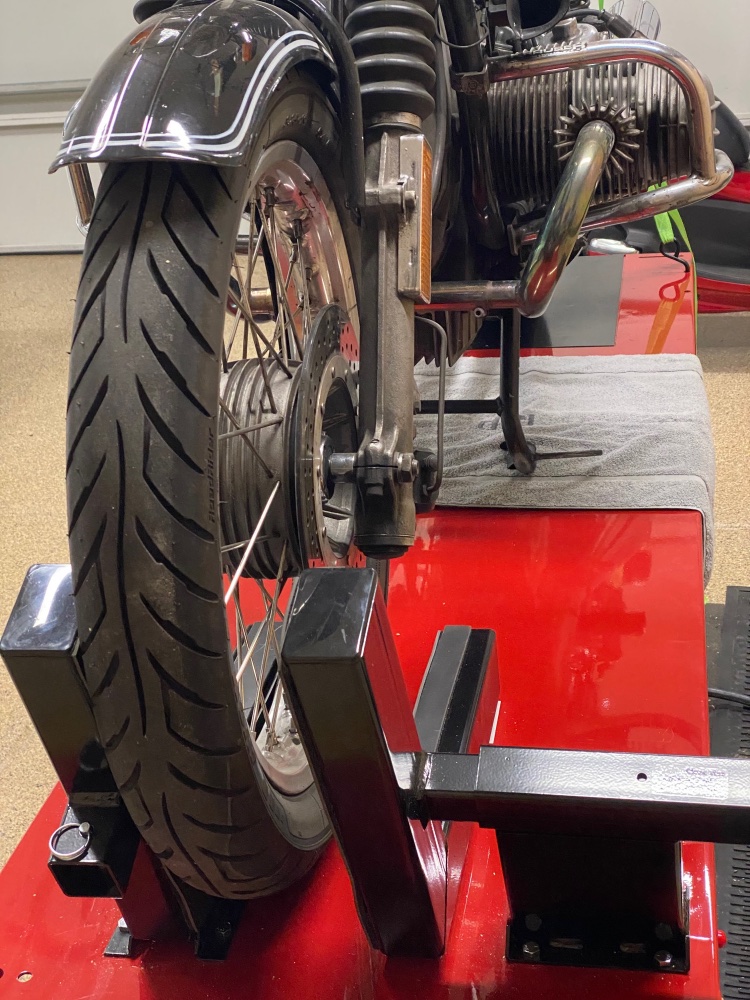
I am working on replacing the taper roller bearings in the front wheel hub so have to remove the front wheel – two axle pinch bolts must be loosened and the axle nut must be removed, along with a washer and spacer, for the axle to be withdrawn and the wheel rolled forward and out onto the workbench. In the next image I have removed the cross brace on the vise and made it possible to remove the wheel forward.
So that inexpensive jack paid for itself very quickly.
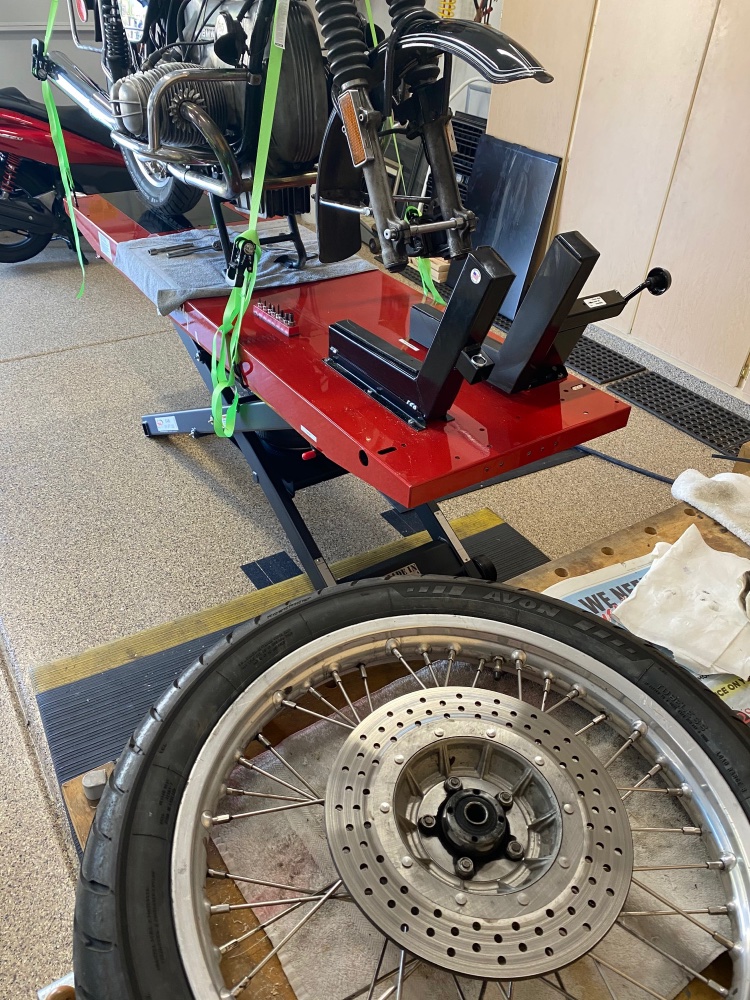
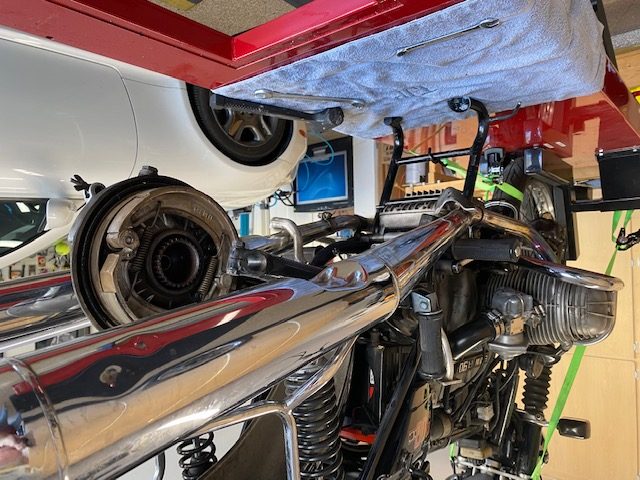
Rear wheel removed, ready for bearing replacement.
Storage of the lift is easy, with movement about the garage greatly facilitated by the furniture dolly:

While I find the smallish workbench adequate for my needs, if additional workspace is needed the lift can be raised to workbench height.
Modifying the scissor jack.
Part III is here.
BMW Airheads appear to be variously balanced when on the center stand. My 1975 R90/6 rests on the rear tire, if lightly so. By contrast, the two R100RTs (1989 and 1994) I have owned rested on the front tire, likely owing to the weight of the large touring fairing on the front axle. Thus, for my 1975, I have to get the weight off the rear wheel if I am to remove it from the bike for tire change or maintenance of the taper roller bearings in the hub. This is how I used to do that in the pre-Handy lift days:
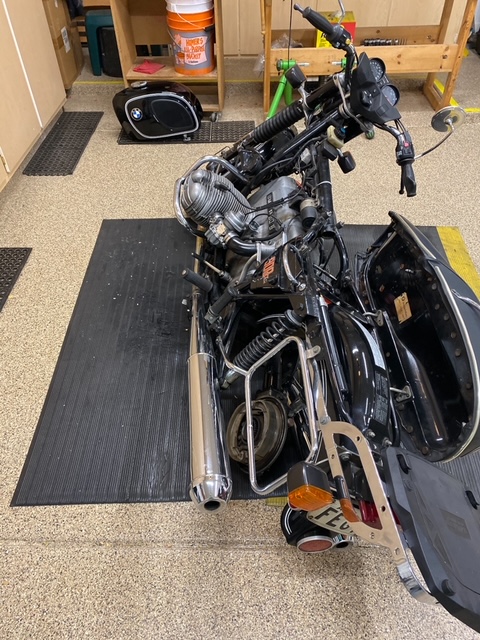
There are many ‘motorcycle’ jacks on Amazon, purportedly designed for two wheeled use. They are mostly flawed as the scissored assembly does not rise centrally to the base, so the higher you go the tippier the whole thing becomes. Plus, at $80 and up they are seriously overpriced. Enter Harbor Freight tools, purveyor of all that is cheap steel and labor from China. Hey, try and find a jack which is not made there. You can bet the one in your fancy top of the line BMW automobile comes from there, too,
They offer a variety of scissor and floor jacks and I opted for the cheapest scissor design, which ran me just $26 with tax, picked up at the local Phoenix store. The greater lifting capacity of the costlier one makes no sense in this application.

However, several modifications are required to make the tool functional for use on the Handy motorcycle lift.
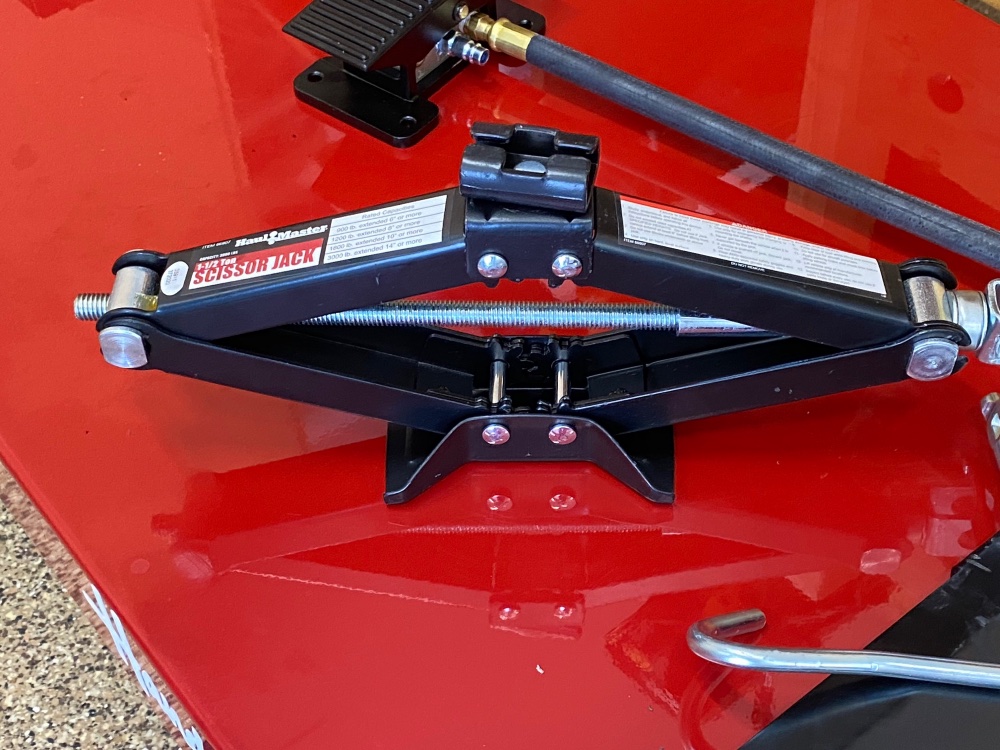
The jack ships with a thoroughly inept hook and rod torquing device to raise and lower the saddle. It comes apart all too easily and is an aesthetic horror show. So I expoxied (using JB Weld – be sure to use the linked product. Their other lines are weaker) a 12mm 3/8″ drive socket into the end jaw which permits attachment of a regular ratchet with an extension. JB Weld, a superb 2-part epoxy, is more than up to this, though a weld would have been nicer. Sadly, I have no welding gear or skills.
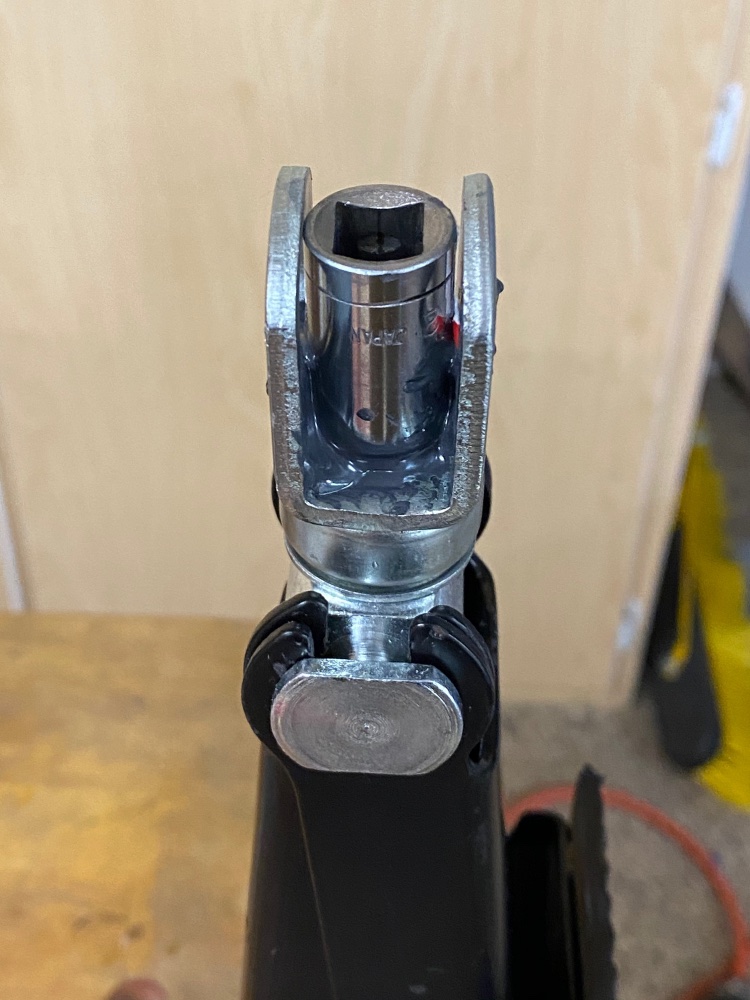
Next, a broader, more stable saddle has to be made to supplement the stock steel one which is intended to locate under a car’s longitudinal rails. A small piece of hard oak does just the trick, and a few minutes with a Makita chop saw and overnight glueing with wood glue is the answer. Oak machines to a very sharp edge so I have knocked off those edges on a Makita flat belt sander. Note that I have also glued a small rubber pad to the metal foot of the jack, to avoid marring the surface of the Handy lift table and to confer anti-slip properties. The glue used was 3M Weatherstrip adhesive.
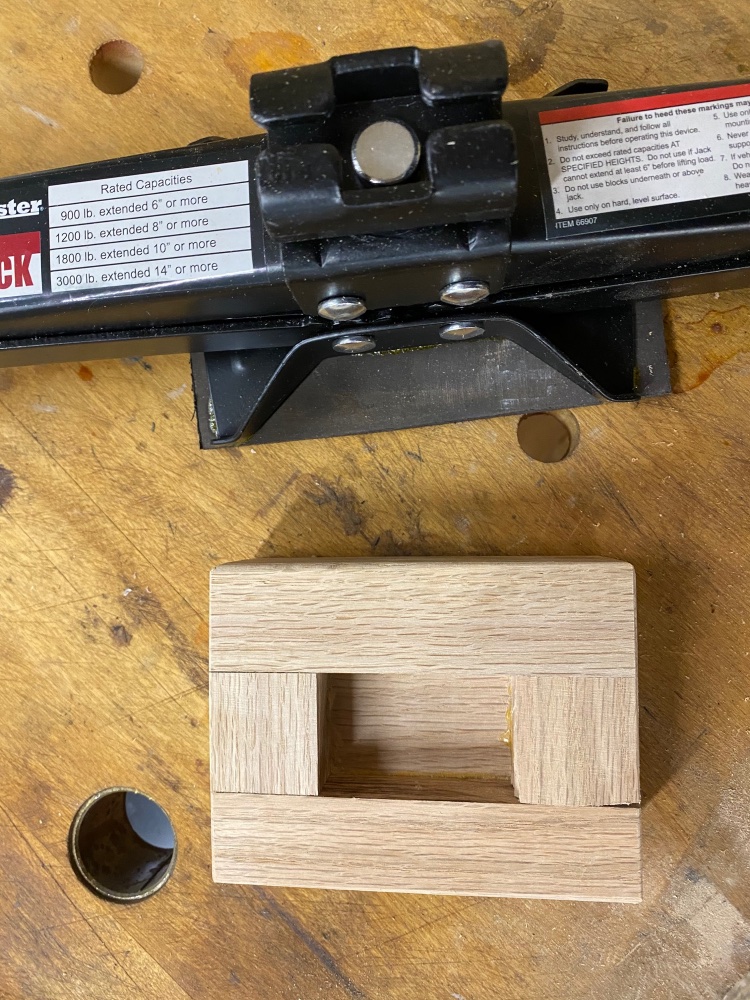
This fits perfectly atop the stock saddle, provides a broad area for the sump of the motorcycle to rest on, and will not mar the finish; I will epoxy it to the stock saddle for a permanent installation:
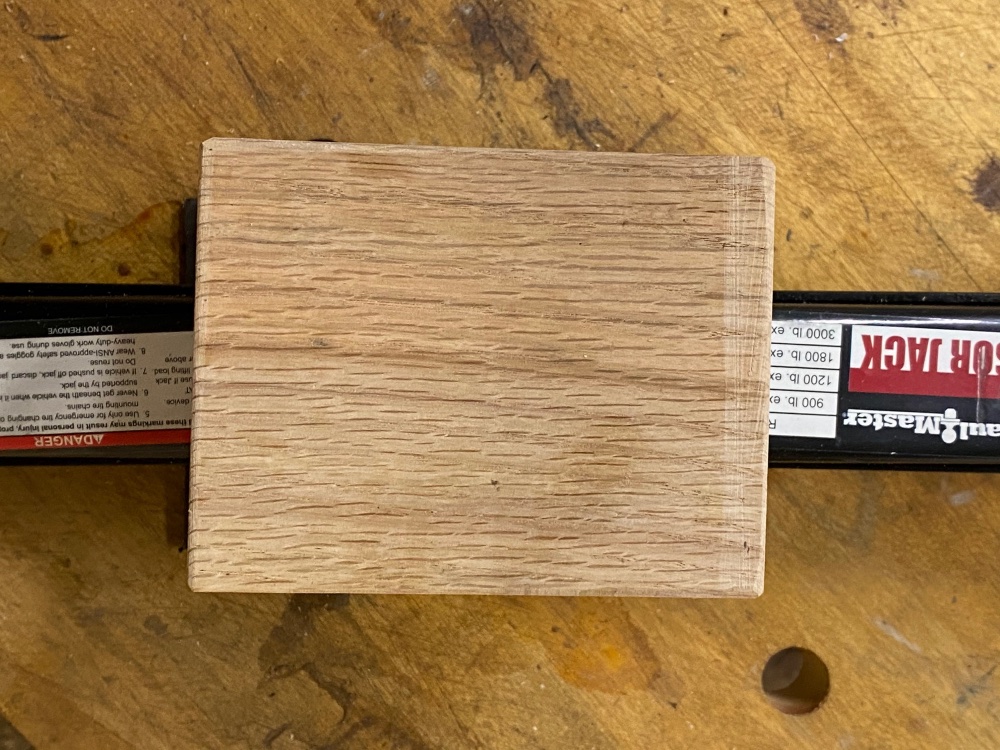
Finally, the screw in the jack needs lubrication and the instruction booklet advises the use of a light oil. This is exactly wrong. What is called for is a thick grease, and I use LiquiMoly LM47, an excellent all purpose grease where high temperatures are not involved:
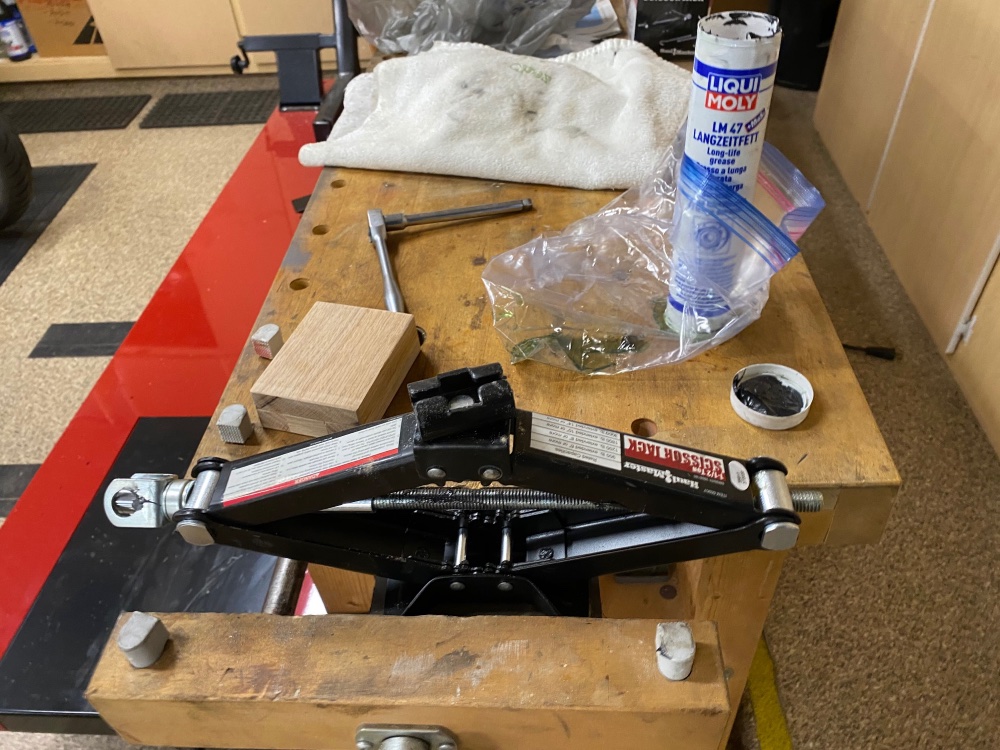
The jack is now ready for use with the motorcycle on the Handy lift.

The width is identical to that of the airhead’s oil pan, to provide maximum contact area. The lifting point will be aligned with the center of gravity of the motorcycle, providing maximum safety. The transverse dimension of the red top is small enough that it will permit full deployment of the center stand once the motorcycle has been lifted, with the front wheel secured in the lift’s vise.
In Part V I look at how the jack is used on the motorcycle lift to remove the front and rear wheels as well as aiding in painless deployment of the center stand on the lift.
The BMW is on board.
Part II appears here.
Before attempting to mount my 1975 BMW R90/6 on the Handy lift, I installed two sets of longitudinal strips of 80 grit non-slip paper under the front rubber mat, spaced to match the front wheels on the lift, and long enough that they just protrude from the rubber mat, allowing correct positioning of the lift. The requirement is that the wheels of the lift bear on the non-slip surface through the rubber mat. The 240″ length of the roll is just right for six 40″ strips, as shown below:
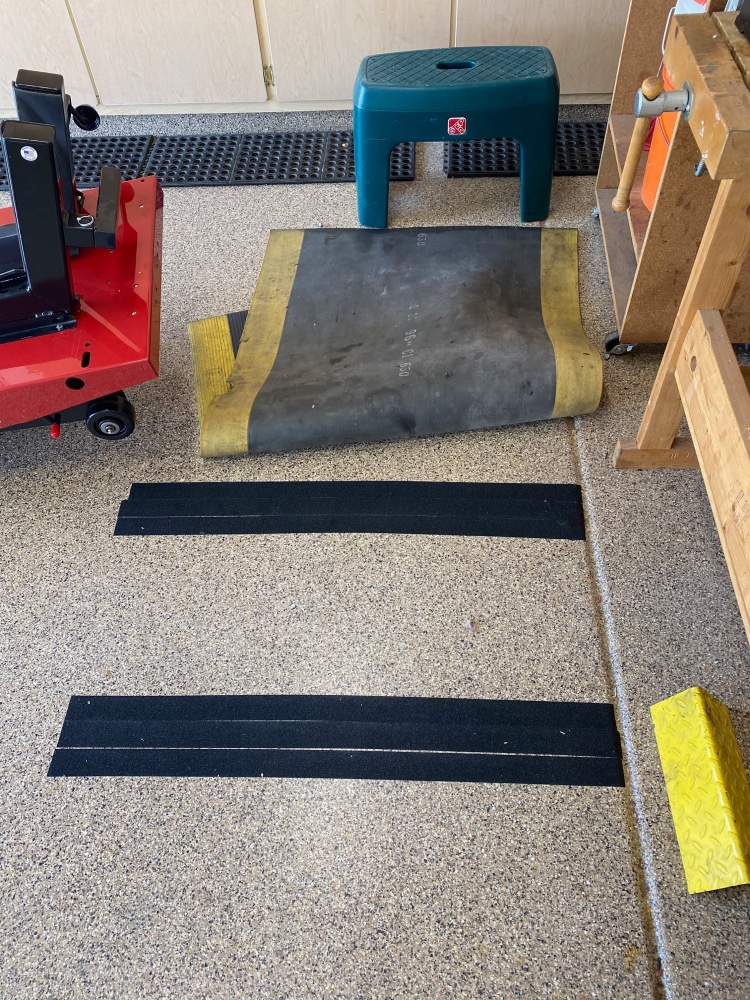
This works perfectly. There is absolutely no slippage of the rubber mat when a machine is rolled onto the lift’s table and the rear rubber mat (see Part II) can be dispensed with.
Before rolling the BMW onto the table I popped off the gas tank – 2 gas lines, 2 thumbscrews and 2 minutes. Try that with any other bike. The weight savings is 30-50lbs. , all of it carried high up and adding unwanted moment of inertia in case the bike starts to tip when being rolled on. Just for luck I solicited my son to push the bike from behind while I got a good run at the ramp. In the event, I could have safely done this solo. With the front wheel in the vise, the two tie downs are installed, just enough to compress the front shocks a half-inch or so, and we are ready to work:
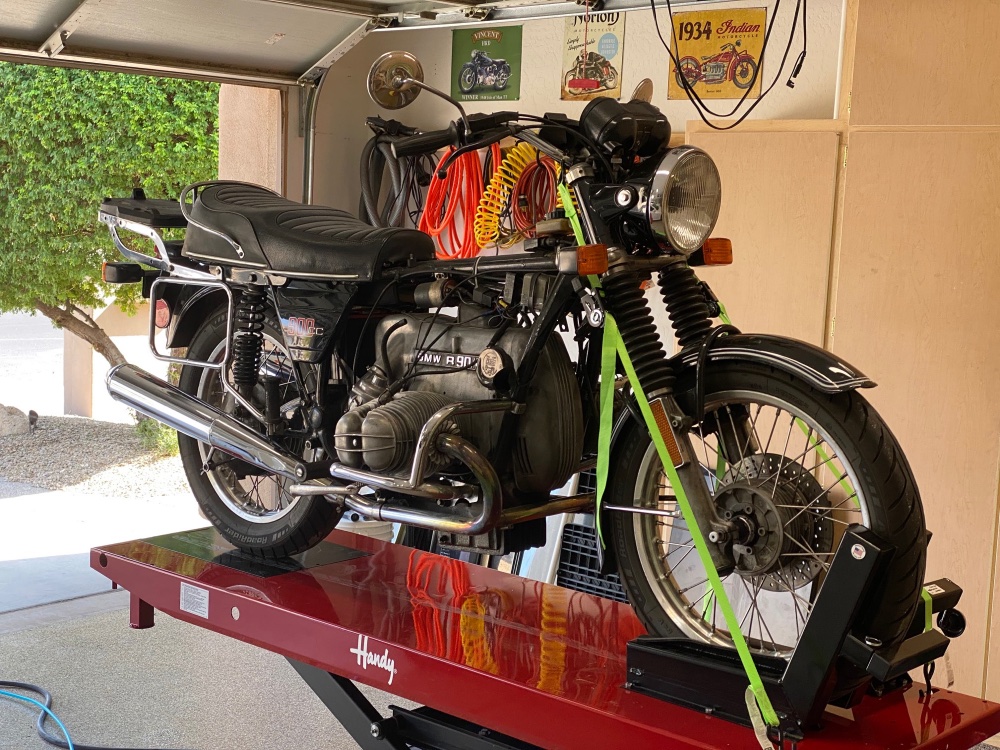
As my first task is to remove the sump to replace a leaking gasket, I had to drain the engine oil, and with everything at eye height it really could not be simpler:
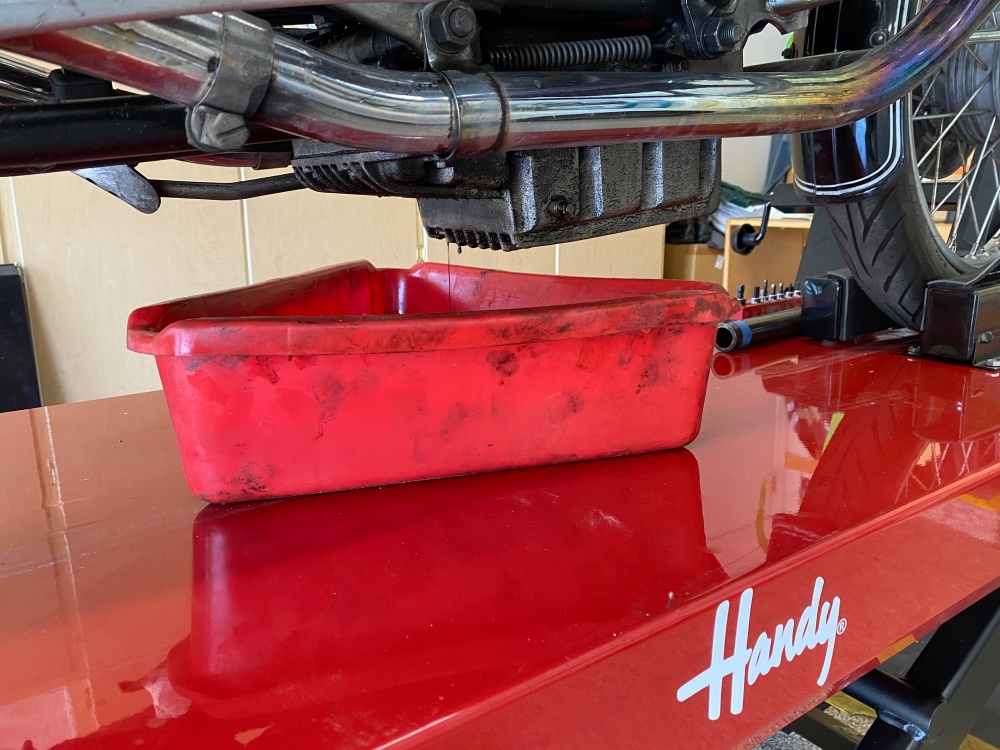
The deep sump cannot be easily removed with the center stand in place so the vise + tie downs approach is just what the doctor ordered.
You can see the lift in operation here:
I have read comments on chat boards from some users stating that the pedal makes excessive noise when releasing air in the down cycle. I have not found this to be the case, and the video, above, confirms my finding.
Conclusion:
My reaction after a couple days of getting familiar with this superb tool? The same as that of any lift buyer: “Why didn’t I get this earlier?”
Why the costly Handy? First, it’s made of thick gauge American steel by American workers. The Iowa factory has been making these for over half a century. It will not tip over or trip you with a base frame as there is none. And at 39″ maximum height it rises 10″ higher than most imports and that is a huge difference. The collapsed height, at 8″, is 1″ more than most of the competition, meaning a little more effort to push a bike up the ramp, the extra height possibly dictated by the rubber bellows. But countersinking this lift into your garage floor is not a good idea. Yes, it will be trivial to roll a bike on or off, but you will lose 8″ of elevation.
The Handy lift is unreservedly recommended for the amateur bike mechanic.
The first task:
On sunny days – we have only 350 of those in a bad year – I like to park the bike on the cement path in front of the home, easily accessible for the afternoon ride, and on display to the neighbors. That cement path shows any oil drips immediately, in the guise of ugly black stains, and such stains had started showing up recently. The cause was a leaking sump gasket, which was finally beginning to give up the ghost after 30 years on the job. The job requires removal of 14 M8 x 1.0 bolts after the oil is drained, a task made impossible by the center stand with the aftermarket deep oil sump I fitted 30 years ago. With the bike on the lift there is no need for a center stand, making those bolts readily accessible. Raising the table to the Handy lift’s full 39″ height places those bolts at a very comfortable height, and after a very leisurely hour or so I had the bolts removed and the sump pan popped off without the need for any persuasion:
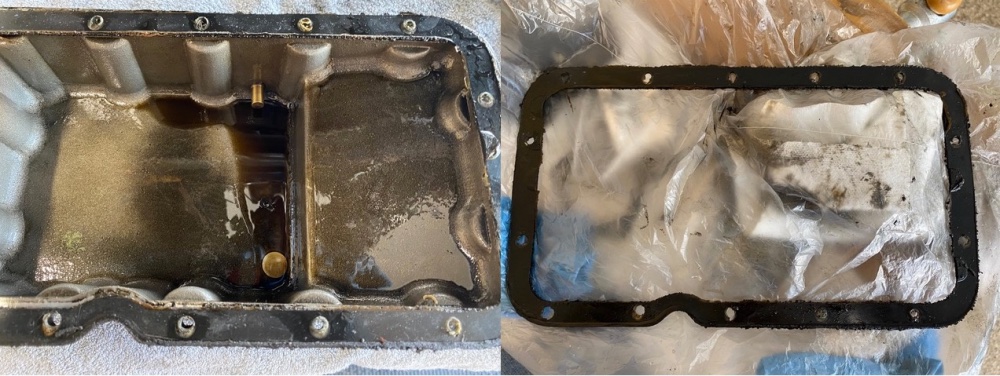
The total absence of any oil sludge in the sump along with the absence of any metal shards in the residue testify to the diligence of regular oil changes during my 30 years of ownership and, indeed, the first 15 years with the original owner. The gasket is made of a paper composite impregnated with a heat sensitive material which helps it seal once the engine and oil are warm, so there’s no need to obsess about absolute planeness of the pan’s mating surface. Just for fun I measured this on a piece of glass and found that the sides were ever so slightly uneven, resulting in a 0.05″ gap. Insignificant, and not worth fixing given the new gasket’s pliability.
The key on reassembly is to use an accurate low range torque wrench to secure those 14 bolts. Hard steel bolts in soft alloy female threads are a recipe for disaster, and are easily over-torqued, resulting in a stripped thread in the engine block. I fastened these first by hand, then using a criss-cross pattern to 4 ft.lbs, using the torque wrench, then a second round with the torque wrench at 8 ft.lbs. That is not very much but it’s all that’s needed. Suffice it to say that the bike passed the cement path test with flying colors, denoted by an absence of any new stains after a vigorous ride. Yes, I cleaned up the old ones. ….
You want to do this job without a motorcycle lift? Good luck.
In Part IV I look at the modifications needed to an inexpensive automobile scissor jack which will allow the rear wheel of the motorcycle to be raised when it is on the motorcycle lift. The jack will also permit easy deployment of the center stand on the motorcycle when it is on the lift with the front wheel clamped in the lift’s vise.